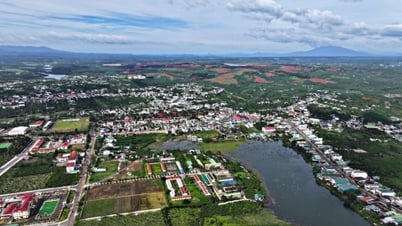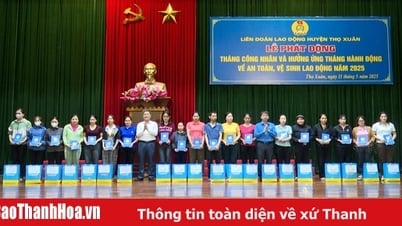The combination of craft villages and tourism contributes to bringing Vietnam closer to international friends as a unique cultural destination; at the same time, craft villages are also a rich source of inspiration for modern creative industries. Van Phuc silk motifs have appeared in high-end fashion collections of many Vietnamese and international designers. Tuong Binh Hiep lacquer paintings are displayed in art exhibitions abroad, while Tan Van pottery has become a source of inspiration for modern interior products.
Despite their great potential, traditional craft villages are still facing many challenges in the context of modernization and globalization. It is not only the risk of extinction but also the degradation and loss of their inherent identity if there is no appropriate strategy. That will be a loss that is difficult to compensate.
In recent times, the Party and the State have issued many policies and guidelines to promote the sustainable development of craft villages in the cultural industry. One of the major orientations is the Program for Preservation and Development of Vietnamese Craft Villages for the 2021-2030 period, approved by the Prime Minister in Decision No. 801/QD-TTg dated July 7, 2022.
The program aims to restore and preserve at least 129 traditional occupations and 208 traditional craft villages at risk of being lost by 2030; recognize 213 new occupations and 96 traditional craft villages; develop about 301 craft villages associated with tourism; more than 80% of craft villages and traditional craft villages operate effectively; 100% of workers in craft villages are trained, retrained, and trained to improve their vocational skills, occupational safety and hygiene skills, and basic information technology knowledge; at least 50% of craft villages have products with protected trademarks. The average growth rate of production value of craft villages is about 10%/year.
Previously, the Government issued Decree 52/2018/ND-CP dated April 12, 2018 on the development of rural crafts, prioritizing support for craft villages at risk of being lost, especially those of ethnic minorities. The policy encourages the development of craft villages linked to the market and international integration, while promoting circular production models, saving raw materials and protecting the environment. This helps craft villages adapt to the green development trend, enhance brand value and bring Vietnamese handicrafts further.
The State also focuses on perfecting the mechanism to honor and reward artisans - the "souls" of craft villages. The Ministry of Culture, Sports and Tourism coordinates with ministries and branches to develop policies to support artisans in developing their careers, participating in training and passing on their skills. The conferment of the title "People's Artisan" or "Excellent Artisan" is not only a recognition but also a motivation for the younger generation to continue the heritage, contributing to solving the problem of human resource shortage. However, for craft villages to truly become a strong resource, making a positive contribution to the cultural industry, the joint efforts of the whole society are needed.
Traditional craft villages are not only valuable assets of Vietnam but can also be considered as one of the "golden keys" to contribute to the goal of developing cultural industry in the new era.
On the State side, it is necessary to issue preferential policies on capital, land, tax, encourage artisans to develop their profession, build training programs for young artisans in a reasonable manner to ensure succession. Organize many fairs, domestic and international trade promotion programs to introduce traditional handicraft products, thereby creating a bridge to help craft villages have the opportunity to promote, introduce products, and find markets.
On the local side, it is necessary to have specific assessments of craft villages to have appropriate support policies. On the craft villages side, it is necessary to increase adaptability, change organization and production structure, enhance cohesion, limit spontaneous, fragmented, small-scale production and business activities, leading to low production and business efficiency; promote initiative, creativity, find directions to adapt to social requirements, such as diversifying product designs, being flexible in accessing technology applications and product marketing, expanding the market; it is necessary to identify digital technology as an indispensable key, craft villages can build introductory videos on social networking platforms to promote products domestically as well as internationally.
According to Professor Claus (Lund University, Sweden), the digitalization process and the application of new technology are important trends in production in craft villages, helping to preserve and maintain the traditions and heritage of craft villages and create connections between those traditions and heritages and the younger generation. In addition, the preservation and development of traditional craft villages needs to integrate multi-value culture such as combining with tourism, bringing craft villages into the journey of discovery.
Each craft village needs to build its own brand, associated with a unique story to create an impression. On the other hand, cooperation with designers, filmmakers, artists and businesses also opens up new opportunities to develop craft villages. In the world, many countries have succeeded in turning traditional craft villages into a resource contributing to the development of the cultural industry, these can be considered valuable lessons for Vietnam.
In Japan, the government has preserved the craft of washi paper and Arita ceramics by providing financial support to artisans, building a national brand, and integrating it with tourism. Visitors can take part in papermaking workshops or try their hand at ceramic art, enhancing the value of the cultural experience.
In Italy, high-end crafts such as leather or Murano glass have become iconic by associating products with brand stories, turning each item into a valuable work of art on the global market. Korea has also cleverly brought craft villages such as Incheon Pottery Village, Jeonju Traditional Paper Village, Hahoe Ancient Mask Village, etc. into films and K-pop, attracting the attention of young people and international tourists.
Traditional craft villages are not only a valuable asset of Vietnam but can also be considered as one of the “golden keys” to contribute to the goal of developing cultural industries in the new era. With the right investment, the support and cooperation of the State, enterprises and the community, and learning from international experiences, Vietnam can completely turn craft villages into an important highlight, contributing to promoting sustainable development from traditional values. That journey is not only a responsibility but also a pride of every Vietnamese in the effort to preserve and spread national identity to the world.
>> Great cultural and economic value
Source: https://nhandan.vn/phat-trien-ben-vung-tu-tai-nguyen-di-san-post868221.html



![[Photo] Prime Minister Pham Minh Chinh chairs the fourth meeting of the Steering Committee for Eliminating Temporary and Dilapidated Houses](https://vphoto.vietnam.vn/thumb/1200x675/vietnam/resource/IMAGE/2025/5/11/e64c18fd03984747ba213053c9bf5c5a)
![[Photo] National Assembly Chairman works with leaders of Can Tho city, Hau Giang and Soc Trang provinces](https://vphoto.vietnam.vn/thumb/1200x675/vietnam/resource/IMAGE/2025/5/11/c40b0aead4bd43c8ba1f48d2de40720e)

![[Photo] Discover the beautiful scenery of Wulingyuan in Zhangjiajie, China](https://vphoto.vietnam.vn/thumb/1200x675/vietnam/resource/IMAGE/2025/5/11/1207318fb0b0467fb0f5ea4869da5517)
![[Photo] The moment Harry Kane lifted the Bundesliga trophy for the first time](https://vphoto.vietnam.vn/thumb/1200x675/vietnam/resource/IMAGE/2025/5/11/68e4a433c079457b9e84dd4b9fa694fe)























![[Video] Prime Minister directs 3 "hot" issues of the education sector](https://vphoto.vietnam.vn/thumb/402x226/vietnam/resource/IMAGE/2025/5/11/7e31b727b1264eda82eca75f579349d1)
![[Photo] Discover the beautiful scenery of Wulingyuan in Zhangjiajie, China](https://vphoto.vietnam.vn/thumb/402x226/vietnam/resource/IMAGE/2025/5/11/1207318fb0b0467fb0f5ea4869da5517)
![[Photo] National Assembly Chairman works with leaders of Can Tho city, Hau Giang and Soc Trang provinces](https://vphoto.vietnam.vn/thumb/402x226/vietnam/resource/IMAGE/2025/5/11/c40b0aead4bd43c8ba1f48d2de40720e)
![[Photo] Prime Minister Pham Minh Chinh chairs the fourth meeting of the Steering Committee for Eliminating Temporary and Dilapidated Houses](https://vphoto.vietnam.vn/thumb/402x226/vietnam/resource/IMAGE/2025/5/11/e64c18fd03984747ba213053c9bf5c5a)


























































Comment (0)